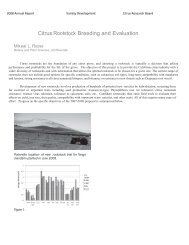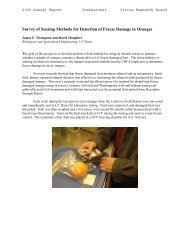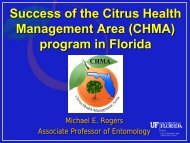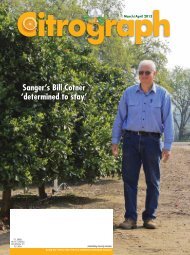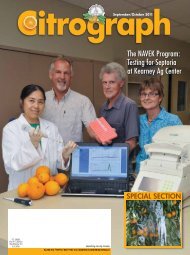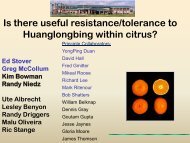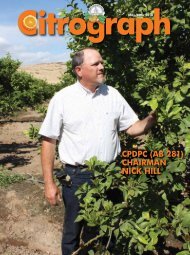Beth Grafton-Cardwell and her team at Lindcove - Citrus Research ...
Beth Grafton-Cardwell and her team at Lindcove - Citrus Research ...
Beth Grafton-Cardwell and her team at Lindcove - Citrus Research ...
Create successful ePaper yourself
Turn your PDF publications into a flip-book with our unique Google optimized e-Paper software.
tapered (Chapot, 1964) (Hodgson, 1967).<br />
This selection was chosen for introduction to the U.S.<br />
due to the <strong>at</strong>tractive horned fruits observed by the staff of<br />
the UCR <strong>Citrus</strong> Variety Collection (CVC), USDA N<strong>at</strong>ional<br />
Clonal Germplasm Repository for <strong>Citrus</strong> <strong>and</strong> D<strong>at</strong>es (NC-<br />
GRCD), <strong>and</strong> CCPP during the ISCN post-conference tour to<br />
Corsica in 1997. However, ‘Bouquetier de Nice’ is consistently<br />
described <strong>and</strong> shown in the liter<strong>at</strong>ure as having fl<strong>at</strong>tened<br />
fruit. The pictures in this description show fruit in a basket on<br />
display in Corsica. The budwood th<strong>at</strong> was given to the CCPP<br />
was supposedly from the tree of which the fruit was taken for<br />
the display. It is possible th<strong>at</strong> the Corsica selection was mislabeled<br />
<strong>and</strong> did indeed represent a cornicul<strong>at</strong>ed selection, a fruit<br />
possessing hornlike extensions. The photograph of the single<br />
fruit was taken from one of two trees in the <strong>Citrus</strong> Variety<br />
Collection in 2011. Most of the fruits on the trees in the CVC<br />
did not have the horns; only a few did. All of the fruits th<strong>at</strong><br />
were cut open showed the secondary fruit. It is possible th<strong>at</strong><br />
this variety needs time to m<strong>at</strong>ure before producing fruit with<br />
horns. More inform<strong>at</strong>ion on this variety will be distributed as<br />
it becomes available.<br />
Left: ‘Bouquetier de Nice’ sour orange, St<strong>at</strong>ion de<br />
Rec<strong>her</strong>ches Agronomiques, Corsica, France. 1997. Right:<br />
‘Bouquetier de Nice’ sour orange, CVC, Riverside, CA.<br />
3/4/2011. Photo by T. Siebert<br />
SRA 507 California Rojo orange (VI 760): First distribution<br />
of buds from the CCPP: September 2010. SRA 507 California<br />
Rojo orange (also known as California Roja orange)<br />
is presumably a mut<strong>at</strong>ion of a st<strong>and</strong>ard navel orange. This<br />
variety was don<strong>at</strong>ed to the Germplasm Agrumes Collection<br />
<strong>at</strong> St<strong>at</strong>ion de Rec<strong>her</strong>ches Agronomiques, Corsica, France,<br />
in 1984 <strong>and</strong> don<strong>at</strong>ed to the CCPP in 1997. ‘California Rojo’<br />
was selected as potentially being of interest to the California<br />
citrus industry by members of the California <strong>Citrus</strong> Nursery<br />
Society during a tour of INRA-CIRAD, Corsica, in conjunction<br />
with the Congress of the Intern<strong>at</strong>ional Society of <strong>Citrus</strong><br />
Nurserymen in 1997.<br />
According to Franck Curk, cur<strong>at</strong>or of the Germplasm<br />
Agrumes Collection <strong>at</strong> St<strong>at</strong>ion de Rec<strong>her</strong>ches Agronomiques,<br />
“in Corsica, ‘Cara Cara’ navel <strong>and</strong> ‘California Roja’ navel are<br />
not <strong>at</strong> the same loc<strong>at</strong>ion, so sometimes we notice some differences<br />
in ripening time or color<strong>at</strong>ion, but globally they really<br />
look like the same. ‘California Roja’ was introduced to Corsica<br />
from Venezuela in 1984, <strong>and</strong> ‘Cara Cara’ was introduced from<br />
Spain to Corsica in 1991”(email of 10/20/2009). Although <strong>at</strong><br />
some point the SRA website provided California as the origin<br />
of this variety, it apparently actually was introduced from<br />
Venezuela <strong>and</strong> so the source of the name is unknown. In any<br />
case, it is apparently the same or very similar as ‘Cara Cara’.<br />
Once the young trees of this cultivar begin producing fruit<br />
“Consulting for<br />
Production<br />
Agriculture”<br />
At Leffingwell Ag Sales we underst<strong>and</strong><br />
the risks you take to grow a successful<br />
crop. Our experienced PCA’s are<br />
prepared with the l<strong>at</strong>est research <strong>and</strong><br />
technologies to help growers deal with<br />
any existing concerns or thre<strong>at</strong>s to<br />
your crops. Please call or come by <strong>and</strong><br />
visit with one of our PCA’s. Hold us to<br />
the task of helping you succeed.<br />
Locally owned<br />
Servicing the citrus belt<br />
for over 60 years<br />
11 PCA’s with over<br />
350 combined years<br />
of experience<br />
3 Convenient Loc<strong>at</strong>ions:<br />
Ivanhoe Lindsay Terra Bella<br />
798-1153 562-4946 535-4461<br />
July/August Citrograph 33




